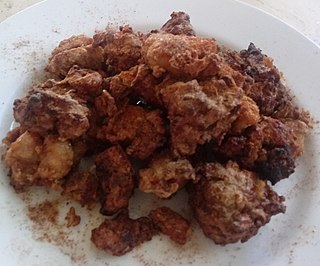
A flavoring, also known as flavor or flavorant, is a food additive used to improve the taste or smell of food. It changes the perceptual impression of food as determined primarily by the chemoreceptors of the gustatory and olfactory systems. Along with additives, other components like sugars determine the taste of food.

Seasoning is the process of supplementing food via herbs, spices, salts, and/or sugar, intended to enhance a particular flavour.

A condiment is a preparation that is added to food, typically after cooking, to impart a specific flavour, to enhance the flavour, or to complement the dish.

Annatto is an orange-red condiment and food coloring derived from the seeds of the achiote tree, native to tropical parts of the Americas. It is often used to impart a yellow to red-orange color to foods, but sometimes also for its flavor and aroma. Its scent is described as "slightly peppery with a hint of nutmeg" and flavor as "slightly nutty, sweet and peppery".

Hot sauce is a type of condiment, seasoning, or salsa made from chili peppers and other ingredients. Many commercial varieties of mass-produced hot sauce exist.

Adobo or adobar is the immersion of food in a stock composed variously of paprika, oregano, salt, garlic, and vinegar to preserve and enhance its flavor. The Portuguese variant is known as carne de vinha d'alhos. The practice, native to Iberia, was widely adopted in Latin America, as well as Spanish and Portuguese colonies in Africa and Asia.

Onion powder is dehydrated, ground onion that is commonly used as a seasoning. It is a common ingredient in seasoned salt and spice mixes, such as beau monde seasoning. Some varieties are prepared using toasted onion. White, yellow and red onions may be used. Onion powder is a commercially prepared food product that has several culinary uses. Onion powder can also be homemade.

The following outline is provided as an overview of and topical guide to the preparation of food:

Chili sauce and chili paste are condiments prepared with chili peppers.
Tajín Clásico, often referred to as simply Tajín, is a Mexican spice mix consisting predominantly of lime, chili peppers and salt. It is used in a variety of preparations.

Butter salt is a seasoning developed in the late twentieth century for the purpose of combining the flavours found in salt and butter. It is a fine, golden powder, originally salt, enriched with butter flavouring. It is often used as a seasoning for popcorn. It is said to impart a "rich, buttery flavour".

Instant soup is a type of soup designed for fast and simple preparation. Some are homemade, and some are mass-produced on an industrial scale and treated in various ways to preserve them. A wide variety of types, styles and flavors of instant soups exist. Commercial instant soups are usually dried or dehydrated, canned, or treated by freezing.

Taiwanese fried chicken, westernized as popcorn chicken, is a dish in Taiwanese cuisine commonly found as street snack and is indispensable to the night markets in Taiwan. It consists of bite-sized pieces of chicken, coated and fried with flour and seasoning mixture. Salt and pepper is the staple condiment, while chili powder, lightly fried basil leaves, and garlic bits are added for preference. Since the creation of this dish, it has become a popular fast food or restaurant appetizer in other countries in Asia, as well as among Asian immigrant populations overseas.
Molly McButter is an American-made flavored butter substitute manufactured by B&G Foods. Originally developed by food chemists at Alberto-Culver, it is a lower-calorie replacement for butter.
Garlic oil is the volatile oil derived from garlic. It is usually prepared using steam distillation, and can also be produced via distillation using ether. It is used in cooking and as a seasoning, a nutritional supplement, and also as an insecticide.












